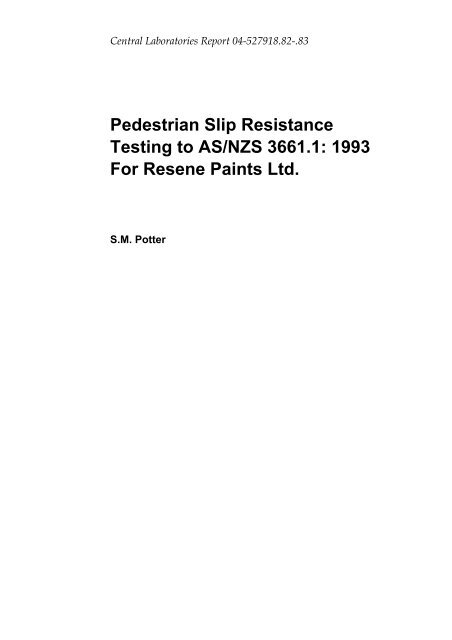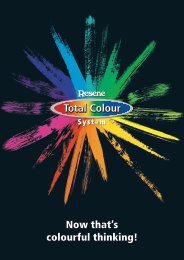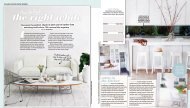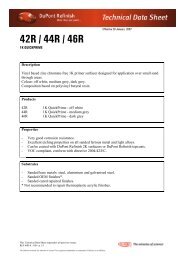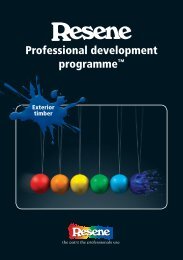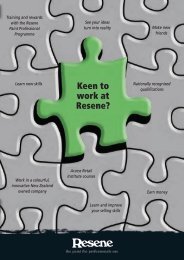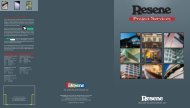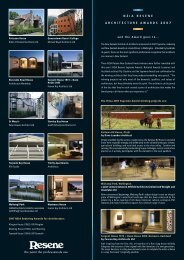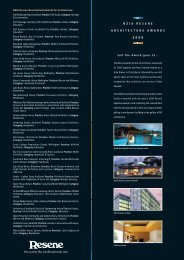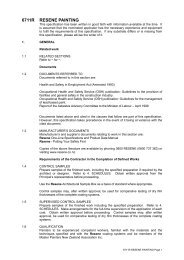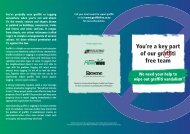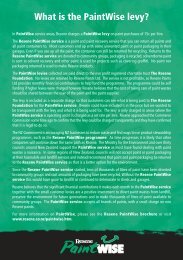Pedestrian Slip Resistance Testing to AS/NZS 3661.1 ... - Resene
Pedestrian Slip Resistance Testing to AS/NZS 3661.1 ... - Resene
Pedestrian Slip Resistance Testing to AS/NZS 3661.1 ... - Resene
Create successful ePaper yourself
Turn your PDF publications into a flip-book with our unique Google optimized e-Paper software.
Central Labora<strong>to</strong>ries Report 04-527918.82-.83<br />
<strong>Pedestrian</strong> <strong>Slip</strong> <strong>Resistance</strong><br />
<strong>Testing</strong> <strong>to</strong> <strong>AS</strong>/<strong>NZS</strong> <strong>3661.1</strong>: 1993<br />
For <strong>Resene</strong> Paints Ltd.<br />
S.M. Potter
Central Labora<strong>to</strong>ries Report 04-527918.82-.83<br />
<strong>Pedestrian</strong> <strong>Slip</strong> <strong>Resistance</strong><br />
<strong>Testing</strong> <strong>to</strong> <strong>AS</strong>/<strong>NZS</strong> <strong>3661.1</strong>: 1993 For<br />
<strong>Resene</strong> Paints Ltd.<br />
S.M. Potter<br />
April 2004<br />
Opus International Consultants Limited<br />
Central Labora<strong>to</strong>ries<br />
Hutt Park Road<br />
PO Box 30 845, Lower Hutt<br />
New Zealand<br />
Telephone: +64 4 587 0600<br />
Facsimile: +64 4 587 0604<br />
DISCLAIMER<br />
Date: May 2004<br />
Reference: 04-527918.82-.83<br />
Status:<br />
This report has been prepared solely for the benefit of the <strong>Resene</strong> Paints Ltd. No liability is accepted by this<br />
company or any employee or sub consultant of this company with respect <strong>to</strong> its use by any other person.<br />
This disclaimer shall apply notwithstanding that the report may be made available <strong>to</strong> other persons for an<br />
application for permission or approval or <strong>to</strong> fulfil a legal requirement<br />
This document and its contents is the property of Opus International Consultants Limited.<br />
Any unauthorised employment or reproduction, in full or part is forbidden.<br />
© Opus International Consultants Limited 2003
Central Labora<strong>to</strong>ries Report 04-527918.82-.83<br />
Client:<br />
Contact:<br />
<strong>Resene</strong> paints Ltd<br />
PO Box 38242<br />
Welling<strong>to</strong>n Mail Centre<br />
Welling<strong>to</strong>n<br />
Jeff Jurlina<br />
Phone: 577 0500<br />
Fax: 577 0600<br />
1 INTRODUCTION<br />
Two samples, comprising five specimens each were prepared and supplied by the client for slip<br />
resistance testing. They were was stated by the client <strong>to</strong> be an acrylic coating called ‘Non-Skid<br />
Deck and Path’ over chip board. Two colours were supplied: ‘Blue Print’ and ‘Off Piste’ they were<br />
given Central labora<strong>to</strong>ries sample numbers 7/04/30 and 7/04/31 respectively.<br />
The client stated that the application rates were a single coat of Quick Dry Acrylic Primer on the<br />
chip board at a rate of 12m 2 /litre followed by 3 coats of the ‘Non-Skid Deck and Path’ at a rate of 6<br />
m 2 /litre.<br />
2 TESTS CARRIED OUT AND B<strong>AS</strong>IS FOR INTERPRETATION<br />
The testing that was applied was in accordance with the joint Australian and New Zealand<br />
standard <strong>AS</strong>/<strong>NZS</strong> <strong>3661.1</strong> : 1993 "<strong>Slip</strong> <strong>Resistance</strong> of <strong>Pedestrian</strong> Surfaces, Part 1 Requirements". The<br />
scope of the standard states that these test methods are appropriate <strong>to</strong> determine the characteristics<br />
of surface materials either in the labora<strong>to</strong>ry, under conditions in which the surface materials are<br />
intended <strong>to</strong> be installed, or in situ following installation. The test method is selected on the basis<br />
of whether the material is <strong>to</strong> be used in either a wet or dry area. The client requested that the<br />
material be tested for the wet condition. The test method is set out in Appendix A of the standard,<br />
namely the pendulum friction tester for the wet condition. A brief description of the instrument is<br />
as follows.<br />
The TRRL Pendulum (pendulum friction tester) has a rigid swinging arm approximately 450 mm<br />
long which contacts the surface with a spring loaded slider about 75 x 20 mm in size, at a speed of<br />
about 2 m/sec. This slider is of a specially designed rubber material (Simulated Standard Shoe<br />
Sole, the 4S rubber) so that the instrument delivers, as far as possible, a response that is<br />
representative of a "typical" pedestrian wearing suitable footwear. This instrument is regarded as<br />
equating the action of pedestrians running, hurrying or turning abruptly as, when wet, it replicates<br />
the aquaplaning effect that is particularly pronounced on smooth or highly glazed surfaces.<br />
The Standard defines wet areas as all external areas plus those internal pedestrian surfaces that are<br />
normally wet during use. It further states that water must be excluded from all dry areas, for<br />
instance by appropriate design. In its notes, the Standard envisages that regula<strong>to</strong>ry authorities<br />
may specify the areas required <strong>to</strong> be slip resistant and whether they are <strong>to</strong> be considered "wet" or<br />
"dry".<br />
c:\resene\opus\04-527918.82-.83.doc<br />
1
Central Labora<strong>to</strong>ries Report 04-527918.82-.83<br />
The results described within this test report are for the materials submitted by the client for testing.<br />
Users of this test reports should determine the extent <strong>to</strong> which the submitted materials are<br />
representative of the batch or variations from batch <strong>to</strong> batch from the supplier’s quality assurance<br />
procedures.<br />
Note that fac<strong>to</strong>rs such as wear, contamination or cleaning procedures may alter the surface<br />
properties and consequently the slip resistance of these materials.<br />
<strong>AS</strong> <strong>3661.1</strong> notes that the pendulum test is less reliable on highly profiled surfaces. This arises in<br />
part because the pendulum test needs <strong>to</strong> be set <strong>to</strong> have a contact path length of 123 – 127 mm. On<br />
the profiled tiles however the spacing of the profile can lead <strong>to</strong> slightly shorter of longer than<br />
specified path, or an abrupt contact by the slider contacting the edge of the highly profiled points.<br />
3 FRICTION REQUIREMENTS OF SURFACES<br />
Friction requirements of surfaces as defined in <strong>AS</strong>/<strong>NZS</strong> <strong>3661.1</strong> are:<br />
Coefficient of Friction – Wet: When tested in accordance with the method set out in Appendix A,<br />
the pedestrian surface shall have a mean coefficient of friction of not less than 0.4 and no specimen<br />
in that sample shall be less than 0.35.<br />
Coefficient of Friction – Dry: When tested in accordance with the method set out in Appendix B,<br />
the pedestrian surface shall have a mean coefficient of friction of not less than 0.4 and no specimen<br />
in that sample shall be less than 0.35.<br />
Note: It would generally be expected that surfaces that have been shown <strong>to</strong> comply with the wet<br />
requirement would also comply with the dry requirement.<br />
Ramps and Other Sloped Areas<br />
For all sloped or graded surfaces with a gradient not less than 2%, the minimum required value for<br />
the coefficient of friction of either wet or dry surfaces as specified above shall be increased in<br />
accordance with the following equation, expressed <strong>to</strong> an accuracy of 0.01:<br />
µ<br />
m<br />
=<br />
100µ + M<br />
100 − Mµ<br />
where µ m = coefficient of friction required for a sloped surface<br />
µ = coefficient of friction obtained on a horizontal surface<br />
M = maximum gradient of slope, in percent<br />
c:\resene\opus\04-527918.82-.83.doc<br />
2
Central Labora<strong>to</strong>ries Report 04-527918.82-.83<br />
This equation is represented in graphical form below:<br />
Coefficient Of Friction<br />
0.7<br />
0.65<br />
0.6<br />
0.55<br />
0.5<br />
0.45<br />
0.4<br />
0.35<br />
2 4 6 8 10 12 14 16 18 20<br />
Maximum Gradient of Slope (%)<br />
Coefficient of Friction Required for a Sloped Surface,<br />
Calculated for µ = 0.4<br />
For example, a surface with a slope of 8% would require a coefficient of friction of 0.5.<br />
Compliance with the slip resistant performance of NZBC D1.3.3(d) may be verified by confirming<br />
that the walking surface, under the expected conditions of use, has a coefficient of friction (µ) of no<br />
less than<br />
µ = 0.4+ 0.0125S<br />
where S is the slope of the walking surface expressed as a percentage.<br />
4 RESULTS<br />
Detailed results for each test area are in the reports that follow in page 4 and 5.<br />
Tested By<br />
Reviewed By<br />
S.M. POTTER<br />
Technical Officer<br />
V.K. DRAVITZKI<br />
Research Manager<br />
(Materials and Environmental Science)<br />
c:\resene\opus\04-527918.82-.83.doc<br />
3
CENTRAL LABORATORIES<br />
Hutt Park Road, Gracefield<br />
P O Box 30-845, Lower Hutt, New Zealand<br />
Phone (04) 587 0600, Fax (04) 587 0604<br />
PEDESTRIAN SLIP RESISTANCE TEST REPORT NO. 04-527918.82<br />
Client: <strong>Resene</strong> Paints Ltd Tested By: ..............................................................<br />
Client’s Reference Order A506584 Date: .......................................................................<br />
Sample No. 7/04/30 Checked By: ..........................................................<br />
Specimen Size 300mm x 300mm Date: ......................................................................<br />
No. of Specimens Tested: Five<br />
DESCRIPTION OF SAMPLE SUPPLIED BY CLIENT<br />
Manufacturer: <strong>Resene</strong><br />
Surface Type: Textured<br />
Colour: Blue Print<br />
Surface Coating: Nil<br />
Material Type: Acrylic on chip board<br />
Common Name: Non-Skid Deck and Path<br />
METHOD<br />
Tests were carried out according <strong>to</strong> <strong>AS</strong>/<strong>NZS</strong> <strong>3661.1</strong> : 1993 <strong>Slip</strong> <strong>Resistance</strong> of <strong>Pedestrian</strong> Surfaces, Part 1 –<br />
Requirements, Appendix A “Method for the Measurement of the Coefficient of Friction of Wet Surfaces”<br />
Type of Test: Fixed Location of Test: Central labora<strong>to</strong>ries<br />
<br />
<br />
A4 preparation for labora<strong>to</strong>ry testing<br />
A5 preparation for in situ testing<br />
Air Temperature: 20°C Relative Humidity: 59%<br />
RESULTS<br />
Appendix A : Wet Surfaces<br />
Specimen No. Test Direction<br />
Mean Coefficient of<br />
Friction<br />
7/04/30 -1 N/A 0.74<br />
7/04/30 –2 N/A 0.78<br />
7/04/30 –3 N/A 0.74<br />
7/04/30 –4 N/A 0.74<br />
7/04/30 –5 N/A 0.74<br />
Sample Mean Coefficient of Friction: 0.75<br />
REQUIREMENTS<br />
Comments:<br />
See Page 2 of this test report<br />
CL 2710 5/97 Opus International Consultants Ltd Page 4 of 4
CENTRAL LABORATORIES<br />
Hutt Park Road, Gracefield<br />
P O Box 30-845, Lower Hutt, New Zealand<br />
Phone (04) 587 0600, Fax (04) 587 0604<br />
PEDESTRIAN SLIP RESISTANCE TEST REPORT NO. 04-527918.83<br />
Client: <strong>Resene</strong> Paints Ltd Tested By: ..............................................................<br />
Client’s Reference Order A506584 Date: .......................................................................<br />
Sample No. 7/04/31 Checked By: ..........................................................<br />
Specimen Size 300mm x 300mm Date: ......................................................................<br />
No. of Specimens Tested: Five<br />
DESCRIPTION OF SAMPLE SUPPLIED BY CLIENT<br />
Manufacturer: <strong>Resene</strong><br />
Surface Type: Textured<br />
Colour: Off Piste<br />
Surface Coating: Nil<br />
Material Type: Acrylic on chip board<br />
Common Name: Non-Skid Deck and Path<br />
METHOD<br />
Tests were carried out according <strong>to</strong> <strong>AS</strong>/<strong>NZS</strong> <strong>3661.1</strong> : 1993 <strong>Slip</strong> <strong>Resistance</strong> of <strong>Pedestrian</strong> Surfaces, Part 1 –<br />
Requirements, Appendix A “Method for the Measurement of the Coefficient of Friction of Wet Surfaces”<br />
Type of Test: Fixed Location of Test: Central labora<strong>to</strong>ries<br />
<br />
<br />
A4 preparation for labora<strong>to</strong>ry testing<br />
A5 preparation for in situ testing<br />
Air Temperature: 20°C Relative Humidity: 59%<br />
RESULTS<br />
Appendix A : Wet Surfaces<br />
Specimen No. Test Direction<br />
Mean Coefficient of<br />
Friction<br />
7/04/31 -1 N/A 0.79<br />
7/04/31 –2 N/A 0.79<br />
7/04/31 –3 N/A 0.79<br />
7/04/31 –4 N/A 0.79<br />
7/04/31 –5 N/A 0.74<br />
Sample Mean Coefficient of Friction: 0.78<br />
REQUIREMENTS<br />
Comments:<br />
See Page 2 of this test report<br />
CL 2710 5/97 Opus International Consultants Ltd Page 4 of 4


